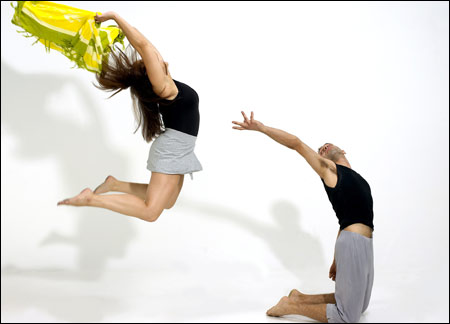The ’80s were a fertile time for dance in Rhode Island, spawning the still-thriving Island Moving Co., Everett Dance Theatre, and Fusionworks. Fusionworks celebrates its 20th season with a fall concert at Rhode Island College (November 17 and 18; 401.456.8144). This program spans the life of the company, from the first dance purchased in 1987 to the newest piece by artistic director Deb Meunier, created this year.

SOARING: Gamba and Rubel.
|
Fusionworks has been defined by its focus on modern dance performed by small ensembles of female dancers (with occasional male dancers joining the company). Meunier has sought inspiration for her choreography in her own life — from childhood memories of her Latina grandmother to the consuming process of renovating a house — and she’s always valued collaboration: with live musicians, with other kinds of dancers, and with established choreographers from throughout the Northeast. In recent years, she has fostered a junior company, Fusionworks II, and two of the principal dancers in this show have come up through those ranks.
Indeed, seeing four pieces in rehearsal last week, it was clear that different dancers always bring different dimensions to a work, whether they drive the energy to a new level, define a crisper body line, or push the emotional content to a greater intensity. All three happened with The Hunt (’02), choreographed by former Parsons Dance Company dancer Robert Battle. Battle made this dance for four men, but when he was commissioned by Fusionworks to adapt it for four women, he did not change or soften any of the steps or gestures.
Set to the throbbing, urgent drums of Leftambours DuBronx, this piece could be mesmerizing with any four dancers, as their percussive movements mirror the music — jumping, stomping, hands slapping thighs, heads whipping side to side — and their gestures pick up the primal fear and rage in the insistent beat. But with company veteran Donna McGuire, new members Melody Gamba and Karen DiIuro, and apprentice member Shauna Edson, the dance finds its strongest voice yet: in the weapon-like hands, in the kung-fu-like kicks and lunges, in the hostile eye contact, in the hisses and snarls that erupt.
At the opposite end of the mood spectrum is ’87’s Jackin’, by Rob Kowalski. Meunier dubs this “’80s club meets modern dance,” and the six dancers in the piece definitely have fun with the first half of that description: hips twisting, shoulders shimmying, prancing one minute, strutting the next, flipping their ponytails, and giving off plenty of attitude. Joining Edson, Gamba, and DiIuro in Jackin’ are Meunier and company members Stephanie Stanford and Mary Manning.
Dancer/choreographer Tim Rubel reprises his role with Meunier in her haunting Fire In the Lake (’89). Set to a mix of Oregon and Elvis Costello, this extended duet deals with an abusive, manipulative relationship and both the dance steps and the facial expressions — Rubel’s suspicious stare, Meunier’s anxious glance, angry glares traded between them — keep us involved with the tangled interactions of such a couple. Rubel grabs Meunier up and tosses her away; she runs in circles away from him; she tries to hold onto her security; he tries to maintain his control. It’s a powerful piece, hard to watch but memorable and moving.
Twenty, created this year in collaboration with percussionist Michael DeQuattro, is a case of “pushing the envelope of density,” Meunier explained, referencing the thick brush strokes of Van Gogh’s later work. With DeQuattro’s interest in Indian music, they began to work on three and five counts and evolved a core section that relies on 20 counts. Thus the title, coinciding with the 20th season. The four dancers paint the air with their arms, reaching up, out, around, and the rest of their bodies flow after those arms, whirling, leaping, swaying.
Two other pieces complete the program: The Moons of Rousseau (’99) and The Parsons Etude (’01). Fusionworks II will present the latter, choreographed by David Parsons. This high-energy piece is full of surprises that always leave you smiling. The former has its humorous moments as well, with five dancers becoming monkeys, slithering fish, and Henri Rousseau’s reclined woman with splayed feet.
These six pieces, infused with the vibrancy of new dancers and the solidity of long-standing ones, give credence to Fusionworks’s motto: “Different is good.”